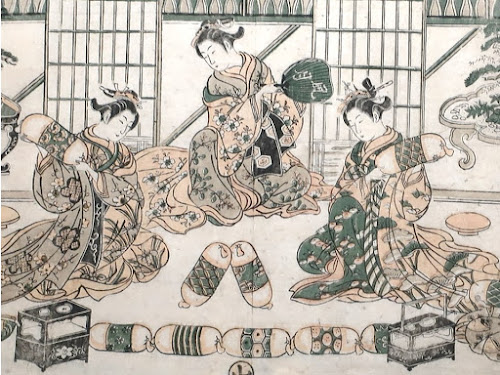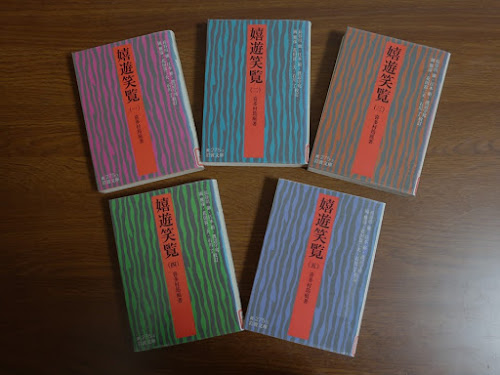Published in 1830
Author : Nobuyo Kitamura、喜多村信節
人の楽しみの発見度:Excellent ★★★
Introduction、はじめに
The author collected many joyful things and events (Kiyu), and provided them as the seeds of laughter (Shouran).The author (1783-1856) was born around 240 years ago, and published it when he was forty-eight. This is an encyclopedia of entertainments.
How did people enjoy their daily life without smartphones?
The answer is written here. Huge amount of entertainments from festivals to prostitutes, are explained.
There were not enough things that made our lives comfortable back then. However, people created tools of entertainments from things at hand including humans, animals and plants. And they had a good time.
There are too many items, so I selected things which I like.
Sumo wrestling game
人々が嬉遊する様々な物事を集めて、笑いの種に供する(笑覧)するという本だ。
著者は、今から約240年前、1783年に生まれ1856年に没した。48歳の時に発刊された遊びの百科事典だ。
スマホもない時代、どのようにして毎日を楽しんだのか。その答えが書いてある。
祭から娼妓まで、膨大なお楽しみごとの由来が書かれ、現状(=江戸後期の状況)が説明されている。
モノは豊富にはない時代の話だ。でも、友人や動植物も含めて、身近にあるもので遊びの種を作ってしまう。不便だったが、人々はふんだんなトキの消費を楽しんだ。
家の造作から始まって、ありとあらゆる嬉遊が書かれているが、人々が楽しむ様子が私の目に浮かんだものだけを選んだ。
I sorted my selected item as the figure below.
My first criterion is how special (rare) or ordinary an event was, and the second is how wholesome or how discreet (unwholesome) an event should be treated. I will divide this to eight parts and write eight articles.
At the beginning, I write about gambles which include creating poems and so on.
選んだ項目を私なりに分類して八本の記事にしていく。まず、ハレの場の楽しみか、日常生活で楽しみか。そしてそれは、ちょっと怪しい楽しみなのか、極めて健康的な楽しみなのかで分けてみた。上記の図になる。作者・喜多村の分類は、この記事の最後に記載した1)。全12巻と附録一巻で構成されている。
人の本性が出る、日常のやや不健康な楽しみ、賭け事から書き始めたい。賭けそのものでなくても、詩歌などが賭けになっている。赤で囲ったところから書いていく。
Gamble、勝負事
Lottery (Vol. 8)、鬮(くじ・巻の八)
A
lottery was recorded on the document of the 8th century, it seemed
to be held to know the providence. Minoh museum where I visited, introduces the local lottery which started
at least in the 16th century. Winning the lottery meant getting the
luck, not money. However, many lotteries to get money started in the Edo period (1603—1868).
Lottery
event in the Edo period, and a current event (left lower)
摂津名所図会に画かれた江戸時代の箕面富と現在の様子(左下)
国会図書館デジタルコレクション https://dl.ndl.go.jp/info:ndljp/pid/2563465
くじについては天平時代から記録されており、神意を伺う事が目的だったようだ。私が訪問した、箕面市立郷土資料館の「箕面の鬮」は、くじに当たった者がその年に幸せになれるということで、金銭は掛けない。しかし、その後、富くじ、宝くじ、として人気になっていく。
This
book introduces the lottery of Mujin group in which members deposited money and
drew a lottery regularly. People casted a spell and relied on superstition such
as keeping a top of a stone monument or a sardine head in their pockets. It’s a
funny practice.
本書には、庶民の間で広まった無尽(グループで掛け金を積み立て、纏めて使う)のくじ引きも書かれている。明和の頃(1764~1772)に盛んに行われていて、まじないをしたり、持仏の飯粒や鰯の頭を懐に入れたり、石塔の宝珠の尖(さき)を持って行ったりして、くじ引きに臨んだ。なかなかのゲン担ぎだ。
People tend to gamble in any event. There are many bookmakers around the world.
Ken-dama(ball) is a traditional Japanese toy, but it was a gambling gadget while drinking. People try to catch the ball on the cup, but if they fail, they drink sake by the cup. It is a harmless entertainment, although we will get drunk easily.
Ken-dama、Shitamachi
Museum 下町風俗資料館
Ken-dama Movie (Basic): https://www.youtube.com/watch?v=c4TDM_avSZUKen-dama Movie (Performance): https://www.youtube.com/watch?v=iFiiXkonsXY
人は、何事につけて、勝ち負けを楽しむのが好きだ。
酒についてもいろいろ書かれていて、狐拳などじゃんけんのようなもので負けると酒を飲む遊びがある。けん玉(拳玉)もその一つだったというので驚いた。「安永六、七年の頃(1777~8年頃)拳玉というものいできたり。猪口の形をして柄あるものなり。それに糸を付けて先に玉を結びたり。鹿角にて造る其玉を投げて猪口の如きものの凹にうけ、さかしまに返して細きかたにとどむるなり。若し受け得ざる者に酒を飲ましむ」とある。確かに玉の受け口は猪口の形だ。可愛いらしい遊びだが、酒が回りそうだ。
The picture of Sumo wrestling using
pillows is shown in Edo-Tokyo Museum. After the pillow went down, the owner of the pillow which fell first would drink sake. It was the New Year’s game in Yoshiwara red light district. It was a similar entertainment.
Bird competition (Vol. 12)、鳥合わせ(巻の十二/上)
【Cockfighting、闘鶏】
The author wrote many trivia. The noble Y.Fujiwara wrote the
cockfighting was held on the 4th of March, so it became the word of
the season that month. He also wrote that fans enjoyed the fighting regardless
of the time of the year.
三月の節物になっているが、これは藤原頼長の日記「台記(たいき)」に「天慶元年三月四日闘鶏十番これあり」ということが基になっているいう。筆者得意のうんちくだ。ただし、好きな者は時期を選ばない、と書いている。
【Japanese bush
warbler (uguisu) competition、鶯の合わせ】
People competed the songs of birds. It is written “the uguisu from Nara is the best, and the one from Nagano is the second. Otsuka village is the good breeding place in Edo.” I think the competition was so exciting because people were concerned about the birth place of birds so much.
Uguisu bird in Ukiyoe printing、風俗四季哥仙 竹間鶯(春信)
国会図書館デジタルコレクション https://dl.ndl.go.jp/info:ndljp/pid/9369420
Song of uguisu (movie): https://www.youtube.com/watch?v=zfmraoicGKY
啼き声を競わせる。鶯の産地について、「奈良にでるを上とし、信州奈良井の産これに次ぐといへり。江戸には大塚村の産をよしとす」と書かれている。産地にこだわる程、盛んだったのだ。「合わせ」はだいたい「合戦」「競争」の意味で使われている。
【Japanese quail competition、鶉(うずら)合わせ】
It was popular in the late 18th century. Daimyo
lords bred the birds, and made elaborate cages with gold or silver.
On the competition day, owners selected birds in good condition, they dressed themselves and their birds completely, and competed with the voice. The quail birds sing in the morning, so the event started early in the morning. The ranking sheet was issued. Wealthy merchants joined it.
They didn’t compete to get money, just to win. It was a really extravagant entertainment. I cannot imagine similar games at present.
On the competition day, owners selected birds in good condition, they dressed themselves and their birds completely, and competed with the voice. The quail birds sing in the morning, so the event started early in the morning. The ranking sheet was issued. Wealthy merchants joined it.
They didn’t compete to get money, just to win. It was a really extravagant entertainment. I cannot imagine similar games at present.
By the way, uguisu birds learn how to sing from other birds,
but quails don’t learn from others. Therefore, people whistled by the
birds and taught them how to sing.
著者が生まれる少し前の明和・安永の頃(1764~1781)に流行ったという。諸侯が競って飼って、鳥籠に金銀をちりばめるなど装飾にも凝った。
鶉合わせの日には、「江戸中の鳥好の者は、是も件の如く劣らじと美を尽くし、風流を巧み、よき鳥をえらび持ち出て、同じく飾り立て、勝負を争う」とある。鶉は朝啼くので、朝早くから会があり、番付を付けた。
「奢遊の町人等、費を厭わず大家の席に連なり、勝を競う。もとより利の為にせず。侈りの甚だしき者なり」と書かれており、ご大人の贅沢な遊びだった。今なら何に相当するだろうか。
また、鶯は啼き声のよい鳥を付けて啼き方を習わすが、鶉はそれができないので口笛を吹いて啼き方を教えるという。
鶉合わせの日には、「江戸中の鳥好の者は、是も件の如く劣らじと美を尽くし、風流を巧み、よき鳥をえらび持ち出て、同じく飾り立て、勝負を争う」とある。鶉は朝啼くので、朝早くから会があり、番付を付けた。
「奢遊の町人等、費を厭わず大家の席に連なり、勝を競う。もとより利の為にせず。侈りの甚だしき者なり」と書かれており、ご大人の贅沢な遊びだった。今なら何に相当するだろうか。
また、鶯は啼き声のよい鳥を付けて啼き方を習わすが、鶉はそれができないので口笛を吹いて啼き方を教えるという。
When I was a child, men gathered at the square and held the
mejiro (white-eye) bird competition. But, it tends to become gambling, and
breeding mejiro is prohibited by Wildlife Protection and Hunting Law. So, I
don’t see it nowadays.
私が子どもの頃は、広場でメジロの啼き合わせをしていたおじさん達がいたが、長らくそのような情景は見なくなった。賭博になりがちなこと、また、自宅でメジロを飼育することが鳥獣保護法の違反になることが原因のようだ。勝負事と賭け事は背中合わせだ。
The bird topics move on to the falconry and the cormorant fishing. He wrote that the hobby fishing was mentioned on the book in the 8th
century “Nihon-shoki”, and so on. He covered immense topics. I extracted only
the topics concerning gambling here.
勝負事ではないが、鳥の話題は、鷹狩りや鵜飼いに及び、下巻では釣りの話に続いていく。趣味の釣りは日本書紀に書かれていて、「事代主の神、遊行ありきて、出雲国三穂之碕に於いて、魚を釣るを以て、楽しみを為す」とあるらしい。巻十二の下には、海、川、様々な魚と釣り道具について書かれている。体系的、かつ、極めて広範囲な記載だ。釣りがお好きな方は、うんちくが増えて良いと思う。
Poems (Vol.3)、詩歌(巻の三)
I
get back to topics about gambling.
Japanese
like to play with words. It is written on the book of the 11th
century “Eiga Monogatari”, that the emperor gathered maids and played with
Chinese characters at the moon viewing party. Such games are popular in the
Japanese TV show now.
勝負事の話に戻る。
日本人も言葉遊びが好きだ。『栄華物語』(11世紀頃)に、月の宴で、醍醐天皇が女房達を集めて、「偏つき」という偏につくりを添えて何の字になるかを問う遊びをしたそうだ。今のクイズ番組に良く見るが、月の宴で、というのが優雅だ。
The
topic moves on to the poem. The next story is written on the famous essay
“Turezuregusa” in the 14th century. A monk, who won a folding
fan and a box at a poem making party, soaked in the river on the way back,
because he was astonished with a cat. Making poems was already a gamble back
then.
言葉遊びは、連歌へと進んでいく。『徒然草』(14世紀)に、連歌の帰りに、法師が猫に驚いて小川に落ち、賭けで取った扇子や小箱が水に浸かってしまったという話が載っている(89段/奥山に猫またといふものありて)。すでに、賭けの対象になっていた。
Making
poem became popular in the Edo period. Around three quarter of samurais
enjoyed it. Some
made poems seriously, some made them for gambling.
Basho, who was the most famous Haiku poem master, criticized, “Some devote their time into getting high score and struggle to win. They don’t make effort to pursue making more excellent poems.”
Some of them treated the wife and children of the judge.
The collected books of high score poems were also popular; “Hikai Mutamagawa” was published in 1750, and nine more volumes followed until 1756.
Basho and his students、芭蕉翁絵詞伝(複製、部分)
詩作は、江戸時代には普及して、『可笑記』(17世紀半ば)には、関東の侍は、百人の内七、八十人が詩作を心得ている、と書かれている。
理屈っぽく取り組んだ人たちもいたが、賭けを伴う連歌にのめり込んだ人も多い。
芭蕉(桃青)が、「点取り(歌には点が付けられた)に昼夜を尽くし、勝負を争い、道を見ずに走り回る者がいる」と批判したぐらいだ。更に、点者(選者)の妻子を腹をふくらす(採点者の接待)と続けるが、こちらは、パトロンとして道の建立の一助になろう、大目に見ている。
高得点の俳諧を集めた本も人気で、『俳諧六玉川(むたまがわ)』は、1750年から1756年まで十篇が発行された。
芭蕉(桃青)が、「点取り(歌には点が付けられた)に昼夜を尽くし、勝負を争い、道を見ずに走り回る者がいる」と批判したぐらいだ。更に、点者(選者)の妻子を腹をふくらす(採点者の接待)と続けるが、こちらは、パトロンとして道の建立の一助になろう、大目に見ている。
高得点の俳諧を集めた本も人気で、『俳諧六玉川(むたまがわ)』は、1750年から1756年まで十篇が発行された。
Some
poems became just for gambling.
The poem consisted of 17 characters (5+7+5). In the 16th century, the master (judge) made the last part of a poem, then participants made the first part.
But the rule changed to the easy one. The master made three kinds of the first part, then participants made the following part. It was called “Mi(three)-kasa(hat)-duke(making)”.
Eventually, the rule became even easier. The master (dealer?) selected the number, then participants selected the same number to win, so it ended up just gambling but no more poetry writing. Many people from the low class to the high joined the game and lost a lot of money. Mikasaduke was prohibited later, but some continued and were sentenced.
The normal poem party is held here,
Souju-an in Nagareyama.The poem consisted of 17 characters (5+7+5). In the 16th century, the master (judge) made the last part of a poem, then participants made the first part.
But the rule changed to the easy one. The master made three kinds of the first part, then participants made the following part. It was called “Mi(three)-kasa(hat)-duke(making)”.
Eventually, the rule became even easier. The master (dealer?) selected the number, then participants selected the same number to win, so it ended up just gambling but no more poetry writing. Many people from the low class to the high joined the game and lost a lot of money. Mikasaduke was prohibited later, but some continued and were sentenced.
一茶ゆかりの流山市双樹庵
ただの賭け事なった詩歌もある。元禄の頃から、宗匠が下の句を出して、参加者が上の句を作って競っていが、上の句を作るのが難しいので、宝永の頃から、冠の五文字を三つ出して各々に七文字・五文字を付けて競う三笠付(みかさづけ)が流行った。
その後、句は作らず、点者(胴元?)が選んだ数字と自分が選んだ数字が一致したら勝ちとなる賭博になった。賤しき者から士君子まで参加して、多くの財を費やして「身を失なひ家を亡ぼすもの数を知らず」となった。結局、三笠付は禁止されたが、それでも「禁を犯して刑にあふるもの」が今も絶えない、という。
その後、句は作らず、点者(胴元?)が選んだ数字と自分が選んだ数字が一致したら勝ちとなる賭博になった。賤しき者から士君子まで参加して、多くの財を費やして「身を失なひ家を亡ぼすもの数を知らず」となった。結局、三笠付は禁止されたが、それでも「禁を犯して刑にあふるもの」が今も絶えない、という。
People
made Senryu and Kyoka which are not too formal poems.
Some of them are written on the lanterns that are hung on the festival day like “Hatsu-uma” even now. They are humorous poems, so visitors enjoy walking around and reading them. Those are wholesome fun for the people.
Some of them are written on the lanterns that are hung on the festival day like “Hatsu-uma” even now. They are humorous poems, so visitors enjoy walking around and reading them. Those are wholesome fun for the people.
肩の張らない川柳や狂歌も作られ、東京の初午などでは地口行灯が飾られる。これは、有名な台詞や格言を滑稽にもじったもので、祭りに訪れた人々が見て楽しむ。こちらは、正統な庶民の楽しみだ。
Shell matching (Vol.4)、貝覆い(巻の四)
One
shell is set on the tatami matt; participants seek for the pair shell from
many shells aside. Beautiful pictures are drawn inside them, so I thought it
was an elegant play for princesses.
BUT, some girls bet the precious picture rolls; it astonished me.
Shells and decorated boxes、源氏の絵を描いた貝と貝桶BUT, some girls bet the precious picture rolls; it astonished me.
Tokyo National Museum 東京国立博物館
貝を伏せておき、出された貝に合う貝を当てる貝覆い。貝には美しい絵が描かれていて、姫の優雅な遊びだと思っていた。ところが、絵巻物を賭けたこともあったというでのビックリ。姫たちの目は血走っていたのだろう。なお、貝合わせは、貝を集めてきて、品比べをしたのだという。
1) Contents of Kiyu-Shouran、嬉遊笑覧の総目(括弧内は私の注釈)
Vo1.1: House, Making-up and so on, Vol.2: Dressing, Belongings
& Instruments, Vol.3: Calligraphy & Painting, Poems, Vol.4: Martial art,
Game, Vol.5: Party, Singing & Dancing, Vol.6: Music, Childish game and so
on, Vol.7: Traveling & Picnic, Festival, Buddhist event, Vol.8:
Celebration, Magic spell and so on, Vol.9: Prostitute, Language, Vol.10: Eating
& Drinking, Fire or lantern event, Vol.11: Business, Beggar, Vol.12: Animal
& Insect. Fishing, Plants, plus Appendix.巻一:居処、容儀(身なり)、巻二:服飾、器用(器などの道具)、巻三:書画、詩歌、巻四:武事、雑技(ゲームなど)、巻五:宴会、歌舞、巻六:音曲、翫弄(子どもの遊びなど)、巻七:行遊、祭祀、佛會、巻八:慶賀、忌諱(厄落としなど)、方術(まじないなど)、巻九:娼妓、言語、巻十:飲食、火燭、巻十一:商売、乞士、巻十二:禽虫、漁猟、草木、合計12巻プラス附録1巻
Previous post:
What
is the fun of Japanese more than hundred years ago? 昔の人々の楽しみとは? (vol.1)Next post (Prostitute、次は娼妓):
Kiyu-Shouran (Entertainment Encycl.) 、嬉遊笑覧 (Part 2)











Hi there, You’ve done an excellent job. I will definitely digg it and personally recommend to my friends. I’m confident they’ll be benefited from this website.
ReplyDeleteLike!! Really appreciate you sharing this blog post.Really thank you! Keep writing. This is my site. พนันบอลออนไลน์ , แทง esport